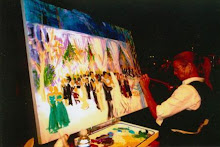
I took this photo from a hibiscus bush in a client's backyard. I've always wanted to paint a large flower, so this became my inspiration. I started with a natural (unbleached) linen canvas. I don't know why-- it just felt right.
I added a golden yellow glaze overall to the background to create a sense of sunlight, as well as emphasize the dark center and petal edges.
Here is the finished painting, with the background darkened even more than the photo, which really makes the hibiscus bloom pop. The shadow cast by the stamen in the center is more prominent-- adding to the sense of dimension.

Without drawing, I just began painting; using the photo loosely for reference, laying in thin washes of color with acrylic paint (called glazes); allowing the colors underneath to glow through.
I find the hibiscus petals to have a sinous, lyrical quality and I tried to capture the grace and flow with my thin linework. I used my lettering brushes (flat, squared tips) to paint the thin lines.
Next, I began to add the dark areas to the background, and light highlights to the flower. Painting is a process of going from background to foreground, dark to light, back and forth and back again.
I added a golden yellow glaze overall to the background to create a sense of sunlight, as well as emphasize the dark center and petal edges.
Here is the finished painting, with the background darkened even more than the photo, which really makes the hibiscus bloom pop. The shadow cast by the stamen in the center is more prominent-- adding to the sense of dimension.

My client loved it so much, she purchased it for her guest bathroom. I left the sides of the canvas unpainted raw canvas, which matched the paint color on the walls.








2 comments:
Yes I DO think!! Very beautiful. Thanks for sharing the process. Mary
You're welcome, Mary!
Post a Comment